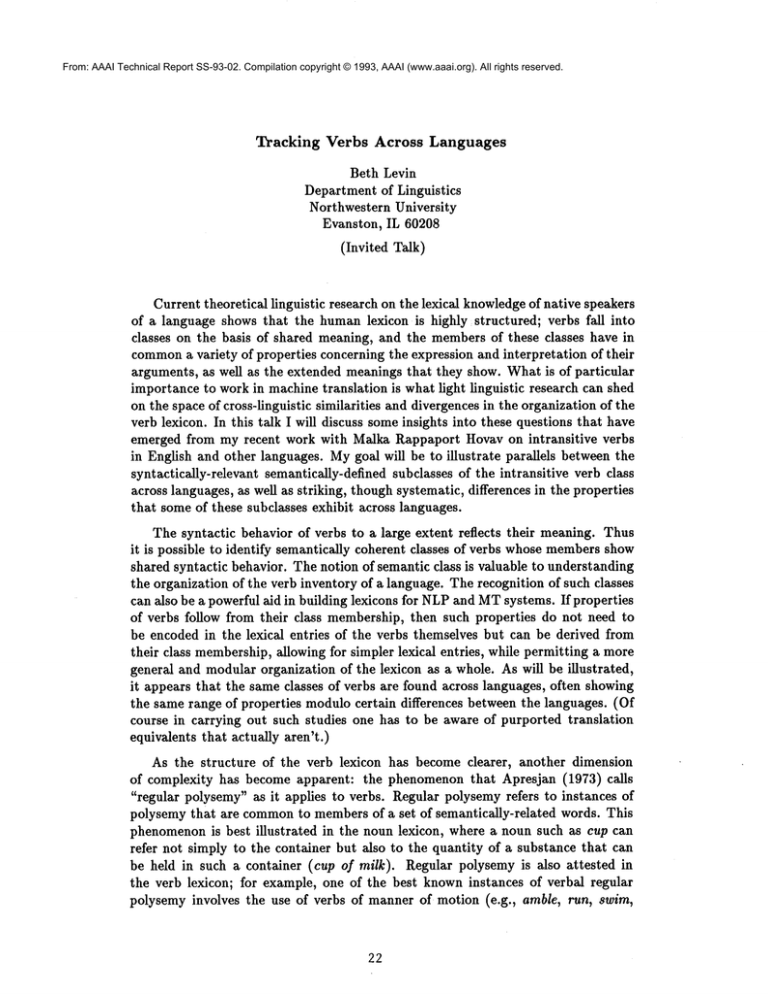
From: AAAI Technical Report SS-93-02. Compilation copyright © 1993, AAAI (www.aaai.org). All rights reserved.
Tracking
Verbs
Across
Languages
Beth Levin
Department of Linguistics
Northwestern University
Evanston, IL 60208
(Invited Talk)
Current theoretical linguistic research on the lexical knowledgeof native speakers
of a language shows that the humanlexicon is highly structured; verbs fall into
classes on the basis of shared meaning, and the membersof these classes have in
commona variety of properties concerning the expression and interpretation of their
arguments, as well as the extended meanings that they show. What is of particular
importance to work in machine translation is what light linguistic research can shed
on the space of cross-linguistic similarities and divergences in the organization of the
verb lexicon. In this talk I will discuss someinsights into these questions that have
emerged from my recent work with Malka Rappaport Hovav on intransitive
verbs
in English and other languages. Mygoal will be to illustrate parallels between the
syntactically-relevant semantically-defined subclasses of the intransitive verb class
across languages, as well as striking, though systematic, differences in the properties
that some of these subclasses exhibit across languages.
The syntactic behavior of verbs to a large extent reflects their meaning. Thus
it is possible to identify semantically coherent classes of verbs whosemembersshow
shared syntactic behavior. The notion of semantic class is valuable to understanding
the organization of the verb inventory of a language. The recognition of such classes
can also be a powerful aid in building lexicons for NLPand MTsystems. If properties
of verbs follow from their class membership, then such properties do not need to
be encoded in the lexical entries of the verbs themselves but can be derived from
their class membership,allowing for simpler lexical entries, while permitting a more
general and modular organization of the lexicon as a whole. As will be illustrated,
it appears that the same classes of verbs are found across languages, often showing
the same range of properties modulo certain differences between the languages. (Of
course in carrying out such studies one has to be aware of purported translation
equivalents that actually aren’t.)
As the structure of the verb lexicon has become clearer, another dimension
of complexity has become apparent: the phenomenon that Apresjan (1973) calls
"regular polysemy" as it applies to verbs. Regular polysemy refers to instances of
polysemy that are commonto membersof a set of semantically-related words. This
phenomenonis best illustrated
in the noun lexicon, where a noun such as cup can
refer not simply to the container but also to the quantity of a substance that can
be held in such a container (cup of milk). Regular polysemy is also attested in
the verb lexicon; for example, one of the best knowninstances of verbal regular
polysemy involves the use of verbs of manner of motion (e.g., amble, run, swim,
22
walk) as verbs of directed motion in some languages (Pat limped; Pat limped into
the room). The existence of regular polysemycan also explain whythe relationships
between semantic class and syntactic behavior are sometimes obscured. Within a
single language, some attempts at identifying verb classes have run into problems
because some verbs show apparently unexpected patterns of syntactic behavior. In
manyinstances, such verbs can be shownto belong to more than one semantic class,
with the problematic conjunction of properties resolving itself once this fact is taken
into account.
Recognizing and understanding regular polysemy is clearly of great importance
to MT.Particularly relevant from the perspective of MTare systematic similarities
and divergences across languages in terms of regular polysemy; these should be
exploited in lexicon construction. This talk will present several examples of crosslinguistic similarities and divergences involving regular polysemyin the intransitive
verb lexicon. The best knownexample of verbal regular polysemy involves the use
of verbs of manner of motion as verbs of directed motion. As shown by Talmy
(1975; 1985), many languages differ from English in not allowing verbs of manner
of motion to have a directed motion use. English also permits verbs of sound (e.g.,
clank, gurgle, screech, whistle) to be used as verbs of directed motion (The truck
rumbled; The truck rumbled into the driveway); this possibility appears to be open
to a subset of the languages which like English allow verbs of manner of motion to
be used as verbs of directed motion. Evidence will be presented in support of this
multiple classification of verbs of sound. This study will also suggest that verbs of
manner of motion are more like verbs of sound than they are like verbs of inherently
directed motion (e.g., arrive, come, descend, go). In concluding this talk, I will
briefly discuss what this unexpected parallel might reveal about the organization
of the verb lexicon and the aspects of verb meaning that need to be included in a
lexical semantic representation.
References
Apresjan,
Ju.D.(1973)
"Regular
Polysemy",
Linguistics
142,5-32.
Talmy,L. (1975)"Semantics
and Syntaxof Motion",
in J.P.Kimball,
ed.,Syntax
andSemantics
4, Academic
Press,New York,181-238.
Talmy,L. (1985)"Lexicalization
Patterns:
Semantic
Structure
in Lexical
Forms",
in T. Shopen, ed., Language Typology and Syntactic Description 3: Grammatical
Categories and the Lexicon, Cambridge University Press, Cambridge, 57-149.
23







